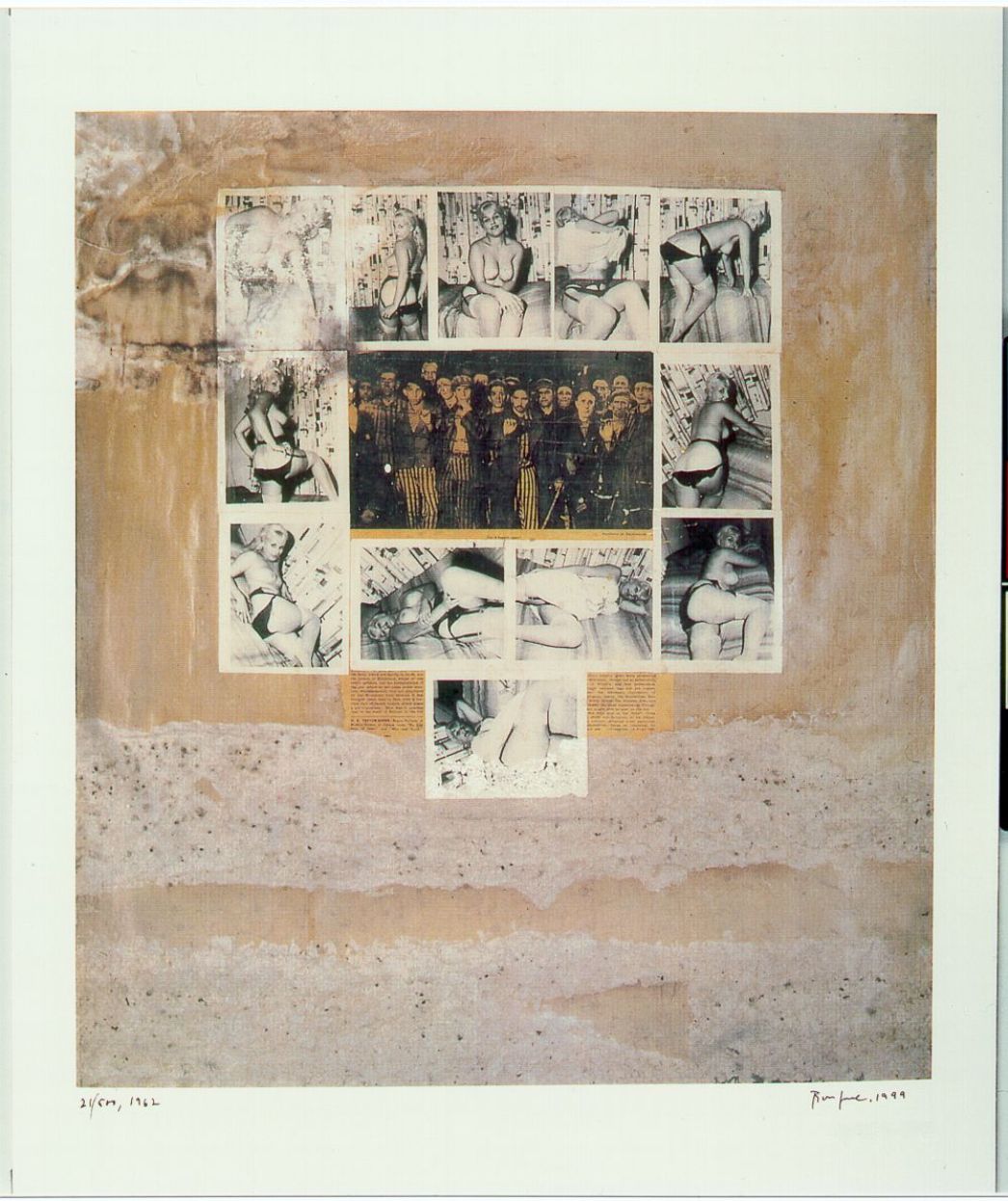
The historical photo at the centre of this collage portrays survivors of the Buchenwald concentration camp a few days after its liberation on 11 April 1945. Life Magazine published the shot by Margaret Bourke-White, who was already quite well-known at the time, on 7 May. Along with the many photos of heaped-up corpses and emaciated human beings with vacant gazes taken in those days, this photo was among those to attain special fame. Between 1959 and 1962, Boris Lurie processed a newspaper print of the photo in a collage. In 1999, he reproduced the collage here on view as an offset print.
Lurie framed the newspaper print of the photo with a photo series of a pin-up girl in different poses, thus linking two themes that are mutually exclusive in the ordinary everyday consciousness. What appears at first sight like a mockery of the victims is in fact a complex reference to the history and the then present. The combination of the two image types serves to create an association of past experiences under SS terror and experiences of the artist’s life in the USA, his country of exile. The collage is unsettling and provocative.
The work is full of associative references and power. Address—and attacking—widespread attitudes of ignorance, jadedness, and voyeurism, it is an example of the spirited, provocative, and irreverent potential of NO!art. Apart from isolated attempts at integration and appropriation, works like this accordingly did not sell on the market.
Works like “Saturation Paintings (Buchenwald)” give expression to a resistance to the themes addressed by Pop art, which emerged in the same period. In the perception of the NO!art artist, the two art currents’ contrasts, in terms of content and message alike, boil down to two words: “YES!” and “NO!” Apart from the societal standpoints they manifest, the two contrary positions also express differing conceptions about the purpose of art: on the one hand art as a representation and affirmation of reality; on the other hand the artistic statement as a mode of cognition and a practical form of revolutionary action.
Biography
Boris Lurie was born in Leningrad (present-day St. Petersburg) on 18 July 1924 and grew up in Riga, Lettland. The invasion of Riga by German troops on 1 July 1941 was followed by the unleashing of violence against the Jewish population. At the mercy of the tyranny and violence of the German occupiers and the domestic collaborators, Lurie was forced to move to the ghetto. The same year, his mother, younger sister, and grandmother were murdered not far from Riga. Boris and his father Ilja Lurie survived barracking and the Riga Lenta SD workshop, the Salaspils and Stutthof concentration camps, and finally the Polte-Werke Magdeburg, a Buchenwald subcamp. They were liberated in Magdeburg by the arrival of American troops in April 1945.
In June 1946, Boris and Ilja Lurie emigrated to New York, where Boris recorded his memories of the camps in small-scale oil paintings in 1947. Later he painted large-scale works with depictions of fragmented female bodies that reveal allusions to the art of Michelangelo and Léger. Boris Lurie arrived at his personal artistic style around 1959 with combinations of collaged and overpainted pieces of torn-out newspaper that link images of the concentration camp with the everyday eroticism of the then present: NO!art.
In the following decades, his works were presented all over the world. In 1998/99, the Buchenwald and Mittelbau-Dora Memorials Foundation mounted a retrospective of works by the artist Boris Lurie of New York. In 2003 the foundation published the accompanying volume “Geschriebigtes/Gedichtigtes” containing texts by the artist in Baltic German.
Boris Lurie died in New York City on 7 January 2008.


